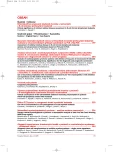Allogeneic stem cell transplantations in multiple myeloma patients – single center experience
Authors:
S. Vokurka; V. Koza; P. Jindra; M. Karas; K. Steinerová; D. Lysák; M. Schutzova; T. Svoboda; V. Vozobulová; M. Švojgrová; L. Mohammadová; A. Jungová; M. Hrabětová
Authors‘ workplace:
Hematologicko-onkologické oddělení, Fakultní nemocnice Plzeň
Published in:
Transfuze Hematol. dnes,15, 2009, No. 4, p. 244-250.
Category:
Comprehensive Reports, Original Papers, Case Reports
Overview
Regardless of its curative potential, the role and indications of the allogeneic stem cell transplantation (SCT) in multiple myeloma remain an issue of discussions. Because of high mortality, morbidity and relapse rate, the allogeneic SCT with myeloablative or reduced-intensity conditioning regimen is not considered a standard treatment approach. The retrospective analysis of our cohort of transplanted patients verified the unacceptable mortality within the conventional conditioning regimen Bu/CY2 (n = 4). In the group of 14 patients after SCT with reduced intensity conditioning regimen FLU/MEL (fludarabine, melphalan), there was the overall response rate of 93% with 43% complete remissions, the transplantation related mortality (TRM) 21%, probability of the 2-year and 4-year progression free survival (PFS) 34% and 17% and the 5-year overall survival (OS) 47%. Better results were observed in patients transplanted without progressive or minimal responding disease. Performing the allogeneic SCT did not limit future treatment of myeloma progressions with the use of bortezomib or thalidomide. Our results are in concordance with those published by other authors. Allogeneic SCT should be performed according to defined protocols and in the frame of multicentre clinical and laboratory cooperation, if possible. The potential of combining the allogeneic SCT with bortezomib, thalidomide or lenalidomide treatment is a challenge for future research.
Key words:
multiple myeloma, allogeneic transplantation, bortezomib, thalidomide
Sources
1. Kyle R, Rajkumar SV. Multiple myeloma. Blood 2008; 111: 2962-2972.
2. Peréz-Simón JA, San Miguel J. HSCT for multiple myeloma in adults. In: The EBMT Handbook 5th Edition – Haematopoietic Stem Cell Transplantation (J. Apperley, E. Carreras, E. Gluckman, A. Gratwohl., T.Masszi – the editors), Forum Service Editore 2008, 415-423.
3. Tricot G, Vesole DH, Jagannath S, Hilton J, Munshi N, Barlogie B. Graft-versus-myeloma effect: proof of principle. Blood 1996; 87: 1196-1198.
4. Le Blanc R, Montminy-Metivier S, Belanger R, et al. Allogeneic transplantation for multiple myeloma: further evidence for a GVHD-associated graft-versus-myeloma effect. Bone Marrow Transplant 2001; 28: 841-848.
5. Durie BG, Harousseau JL, Miguel JS, et al. International uniform response criteria for multiple myeloma. Leukemia 2006; 20: 1467-1473.
6. Filipovich AH, Weisdorf D, Pavletic S, et al. National Institutes of Health consensus development project on criteria for clinical trials in chronic graft-versus-host disease: I. Diagnosis and staging working group report. Biol Blood Marrow Transplant 2005; 11: 945-956.
7. Devergie A. Graft versus host disease. In: The EBMT Handbook 5th Edition – Haematopoietic Stem Cell Transplantation (J. Apperley, E. Carreras, E. Gluckman, A. Gratwohl., T. Masszi – the editors), Forum Service Editore 2008, 219-234.
8. Glucksberg H, Storb R, Fefer A, et al. Clinical manifestations of graft-versus-host disease in human recipients of marrow from HL-A-matched sibling donors. Transplantation 1974; 18: 295-304.
9. Bruno B, Rotta M, Patriarca F, et al. Nonmyeloablative allografting for newly diagnosed multiple myeloma: the experience of the Gruppo Italiano Trapianti di Midollo. Blood 2009; 113: 3375-3382.
10. Garban F, Attal M, Michallet M, et al. for the Intergroupe Francophone du Myélome and the Swiss Group for Clinical Cancer Research. Prospective comparison of autologous stem cell transplantation followed by dose-reduced allograft (IFM99-03 trial) with tandem autologous stem cell transplantation (IFM99-04 trial) in high-risk de novo multiple myeloma. Blood 2006; 107: 3474-3480.
11. Kröger N, Sayer H, Schwerdtfeger R, et al. Unrelated stem cell transplantation in multiple myeloma after a reduced-intensity conditioning with pretransplantation antithymocyte globulin is highly effective with low transplantation-related mortality. Blood 2002; 100: 3919-3924.
12. Crawley Ch, Lalancette M, Szydlo R, et al. for the Chronic Leukaemia Working Party of the EBMT. Outcomes for reduced-intensity allogeneic transplantation for multiple myeloma: an analysis of prognostic factors from the Chronic Leukaemia Working Party of the EBMT. Blood 2005; 105: 4532-4539.
13. Giralt S, Thall PF, Issa K, et al. Melphalan and purine analog-containing preparative regimens: reduced-intensity conditioning for patients with hematologic malignancies undergoing allogeneic progenitor cell transplantation. Blood 2001; 97: 631-637.
14. Siegel S, Wagner A, Friedrichs B, et al. Identification of HLA-A*0201-Presented T Cell Epitopes Derived from the Oncofetal Antigen-Immature Laminin Receptor Protein in Patients with Hematological Malignancies J Immunol 2006; 176: 6935-6944.
15. Costa LJ, Kumar S, Dispenzieri A, et al. Factors associated with favorable outcome after allogeneic hematopoietic stem cell transplantation for multiple myeloma. Leuk Lymphoma 2009; 50: 781-787.
16. Hájek R, Adam Z, Maisnar V, et al. Diagnostika a léčba mnohočetného myelomu – doporučení vypracované Českou myelomovou skupinou, Myelomovou sekcí České hematologické společnosti a Slovenskou myelómovou spoločností pro diagnostiku a léčbu mnohočetného myelomu. Transfuze a Hematol dnes 2009; 15(Suppl. 2): 3-80.
17. Rotta M, Storer B, Sahebi F, et al. Long-term outcome of patients with multiple myeloma after autologous hematopoietic cell transplantation and nonmyeloablative allografting. Blood 2009; 113: 3383-3391.
18. Gahrton G, Björkstrand B. Allogeneic transplantation in multiple myeloma. Haematologica 2008; 93: 1295-1300.
19. Crawley Ch, Iacobelli S, Björkstrand B, Apperley J, Niederwieser D, Gahrton G. Reduced-intensity conditioning for myeloma: lower nonrelapse mortality but higher relapse rates compared with myeloablative conditioning. Blood 2007; 109: 3588-3594.
Labels
Haematology Internal medicine Clinical oncologyArticle was published in
Transfusion and Haematology Today

2009 Issue 4
Most read in this issue
- Congenital polycythemias
- The role of FLT3 mutations in the pathogenesis of acute myeloid leukemia
- Assessment of minimal residual disease in B-cell chronic lymphocytic leukemia: options and advancement of techniques based on PCR and RT-PCR
- Therapy-related myelodysplastic syndrome: a retrospective analysis of data from the Czech Working MDS Group registry
